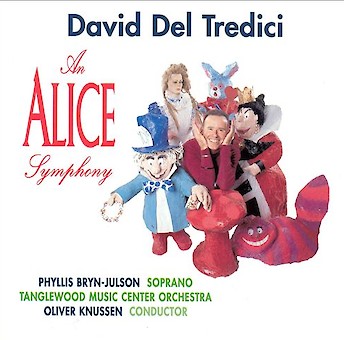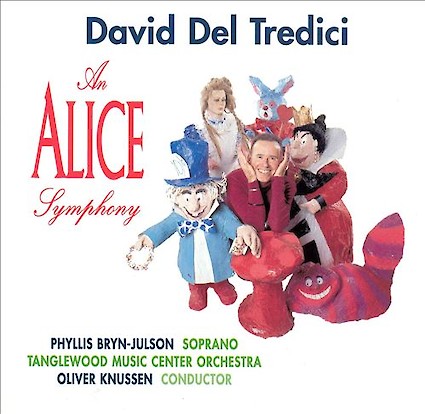An Alice Symphony is a setting of four poem-scenes from Lewis Carroll's Alice's Adventures in Wonderland. At the beginning and end of the piece is a simulation of the pre-concert tuning ritual (slightly formalized in each instance into a palindrome). This is meant as a suggestion of the 'real' world ('dull reality') from which Alice escapes down the rabbit hole and to which she returns at the end of the story. The opening and closing moments derive much of their material from these opening sounds (particularly the open fifths in the strings).
'Speak Roughly/Speak Gently' is taken from the 'Pig and Pepper' chapter of Alice. This is a particularly bizarre scene, with the poem being a sort of lullaby which the Duchess sings as she alternately nurses and violently shakes her baby (which later turns into a pig!).
I have tried to capture all the brutishness of this scene, to emphasize its decidedly non-lullaby quality. However, the poem 'Speak Roughly' is also a parody of another poem which was well known to Carroll's audience: 'Speak Gently' by David Bates. It reflects a totally opposite feeling, being all Victorian sweetness, gentleness, and sentiment.
As the two poems represent two extremes of feeling with very little middle ground, so too does the music, which is either brutally loud or whisperingly soft. As a further enhancement of these contrasts, I have used different kinds of amplification for each poem. During 'Speak Roughly,' the soprano sings through a Bull-horn which grossly distorts, and in 'Speak Gently,' the soprano sings through an echo-chamber device, which gives the sounds a particularly haunting far-away quality.
In the second movement, Alice comes upon the Mock Turtle and the Gryphon, who describe to her and then perform in an amusingly awkward manner the dance known as 'The Lobster Quadrille.' Between sections of the dance the Mock Turtle sings a song. As soon as they have finished this, they ask Alice to do something for them in return, and she obliges, rather timidly, with her song, 'Tis the Voice of the Sluggard.'
'The Lobster Quadrille' is in seven parts. I was intrigued with the idea and possibilities of writing music which worked both separately and then when superimposed simultaneously one atop the other ? hence the special partitioning of the orchestra in half (brass, strings/woodwinds, percussion). The three-verse Song for soprano and folk instruments acts as a kind of trio between the different dances.
"My musical image for the next movement, Alice's song, came from a phrase in the text, '...she hardly knew what she was saying; and the words came very queer indeed.' That is, I endeavored to write a music which sounds slightly 'out of kilter' with itself ? strangely out of focus. As the text itself is contradictory (the title Alice announces is ' 'Tis the Voice of the Sluggard,' but the first line she sings is, ' 'Tis the Voice of the Lobster') so, too, is the music. Much of the time the soprano and orchestra perform the same melodic line, but they never coincide properly; one is always getting ahead of or behind the other. Then I found irresistible the idea of musically suggesting the 'voice' of the Lobster itself, which, of course, is like the sound of one hand clapping.
'Who Stole the Tarts?' is taken from the last chapter of the book of the book and is the White Rabbit's very important deposition of evidence against the Knave of Hearts. The entire court is assembled: the King, the Queen, and Alice. However, with its confusion of pronouns, the six verses of the poem make very little sense.
My setting is one which emphasizes the seriousness of the presentation, rather than the nonsense of the poem itself. The music begins softly and gradually builds through the verses to ever grander and grander statements of always the same theme. The music treats the words as the White Rabbit must have thought of them and wanted them to be: grand and impressive before the grandest, most impressive audience in Wonderland. (The text of this song I have subsequently set, in totally different fashion, as Aria I of Final Alice.)
Alice's return to reality is accomplished by the music's gradual emphasis of the oboe's 'tuning' A, and the open strings of the orchestra, ending finally with a written-out version of the actual ritual an orchestra always performs at the beginning of any concert. This to me was the 'dull reality' mentioned in the text."
An explosion of energy and color in the service of music that is all energy and color. This wonderland, wonderfully evoked by Knussen and his enthusiastic players, bears some resemblance to a madhouse.
An impeccable performance... Revels in the frenzied spirit of childlike wonder and maniacal humor.
The performance is a remarkable achievement, especially soprano Bryn-Julson's multifaceted rendition of the various charaters. CRI has produced a recording that is central to the history of music in this country in the past quarter century (three stars).
Often loud and violent...qualities fully realized in a boisterous performance.
An imaginative aural phantasmagoria
One year before the Beatles wrought their psychedelic opus Sgt. Pepper's, this American composer had, in a sense, already beaten them to the punch.
Audio (1)
Recordings (1)


David Del Tredici: An Alice Symphony / Phyllis Bryn-Julson / Oliver Knussen
1995, CRI/New World Records (688)Works
Performers
- Phyllis Bryn-Julson, Soprano
- Oliver Knussen, Conductor
- Tanglewood Music Center Orchestra